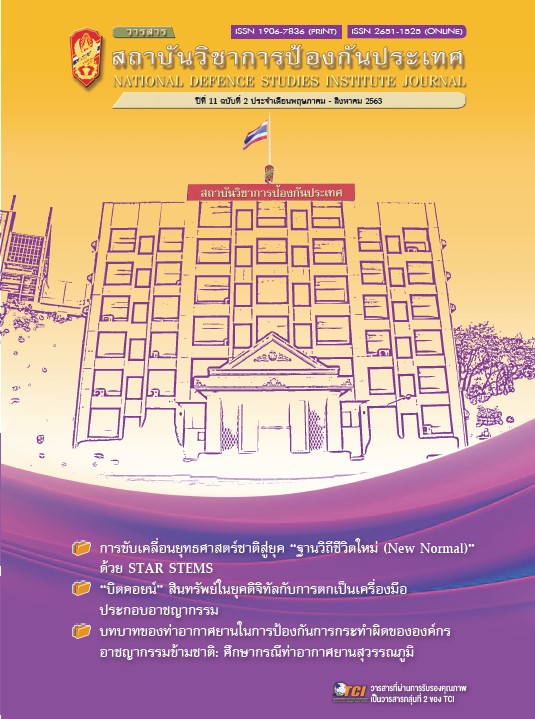A Model of Confirmatory Factor Analysis of Communication Behavior in Organization through Social Media of the Armed Forces Academies Preparatory School
Main Article Content
Abstract
This research aims to analyze and verify a model of confirmatory factor analysis of Communication behavior in organizations through social media use of the Armed Forces Academies Preparatory School personnel. The sample group in this research includes 400 Armed Forces Academies Preparatory School personnel who use the LINE application for internal communication, selected by simple random sampling. The questionnaire is composed of the seven-point scale with reliability at 0.98 is applied to the collection of the data. The statistics used for data analysis are skewness, kurtosis, and the second order confirmatory factor analysis. The findings are as follows: a model of confirmatory factor analysis of communication behavior in organizations through social media use of the Armed Forces Academies Preparatory School personnel consists of six factors which are 1) performance expectancy for social media, 2) effort expectancy of using social media, 3) social influence toward the use of social media, 4) facilitating conditions of the use of social media, 5) behavioral intention of using social media, and 6) behavior of using social media for internal communication. The result of this research is consistent with the empirical data. The standardized factor loading of every indicator shows high criterion with statistical significance at 0.001 and can be utilized to measurecommunication behavior in organizations.
Article Details
The articles, images, tables, graphs, written content, and opinions published in this journal are solely those of the authors and do not necessarily reflect the views or positions of the National Defence Studies Institute or its academic affiliates.
References
กริช แรงสูงเนิน. (2554). การวิเคราะห์ปัจจัยด้วย SPSS และ AMOS เพื่อการวิจัย. กรุงเทพฯ: ซีเอ็ดยูเคชั่น.
ฉัตรเฉลิม เกิดสวัสดิ์ และ สุมามาลย์ ปานคา. (2560). รูปแบบความสัมพันธ์เชิงสาเหตุของการยอมรับและการใช้เทคโนโลยี
ที่มีต่อพฤติกรรมการสื่อสารภายในองค์กรผ่านโซเชียลมีเดียของข้าราชการโรงเรียนนายร้อยพระจุลจอมเกล้า.
ใน 3rd National and International Conference on Education Research and Social Development
-28 April 2017 (หน้า 120-126). ปทุมธานี: มหาวิทยาลัยรังสิต.
ชไมพร กาญจนกิจสกุล. (2555). ระเบียบวิธีวิจัยทางสังคมศาสตร์. ตาก: โพรเจ๊คท์ ไฟฟ์-โฟว์.
ชัยวิชิต เชียรชนะ. (2558). การใช้สถิติหลายตัวแปรเพื่อการวิจัย: การออกแบบ การวิเคราะห์ และการตีความหมาย.
กรุงเทพฯ: สามลดา.
ชูศรี วงศ์รัตนะ. (2560). เทคนิคการสร้างเครื่องมือวิจัย: แนวทางการนำไปใช้อย่างมืออาชีพ. กรุงเทพฯ: อมรการพิมพ์.
นงลักษณ์ วิรัชชัย. (2542). โมเดลลิสเรล: สถิติวิเคราะห์สำหรับการวิจัย (พิมพ์ครั้งที่ 3). กรุงเทพฯ: โรงพิมพ์แห่งจุฬาลงกรณ์
มหาวิทยาลัย.
บุญชม ศรีสะอาด. (2556). วิธีการทางสถิติสำหรับการวิจัย เล่ม 1 (พิมพ์ครั้งที่ 5). กรุงทพฯ: สุวีริยาสาส์น.
พูนเพิ่ม เสรีวิชยสวัสดิ์ และ เกิดศิริ เจริญวิศาล. (2562). การยอมรับและการใช้เทคโนโลยี: บทบาทสำคัญต่อพฤติกรรม
เชิงสร้างสรรค์ของบุคลากรในอุตสาหกรรมไมซ์ของประเทศไทย. วารสารวิทยาลัยดุสิตธานี, 13(3), 505-519.
ยุทธ ไกยวรรณ์. (2557). การวิเคราะห์สถิติหลายตัวแปรสำหรับงานวิจัย. กรุงเทพฯ: สำนักพิมพ์แห่งจุฬาลงกรณ์ มหาวิทยาลัย.
โรงเรียนเตรียมทหาร สถาบันวิชาการป้องกันประเทศ. (2562). ข้อมูลกำลังพลโรงเรียนเตรียมทหาร สถาบันวิชาการ
ป้องกันประเทศ ปี 2562. กองกำลังพล โรงเรียนเตรียมทหาร สถาบันวิชาการป้องกันประเทศ.
วิริยาภรณ์ เตชะกฤตธีรพงศ์ และ ศรีสมรัก อินทุจันทร์ยง. (2559). ปัจจัยการยอมรับการใช้งานเทคโนโลยีการทำงานร่วมกัน
ของบุคลากรในองค์การในประเทศไทย. (การค้นคว้าแบบอิสระวิทยาศาสตรมหาบัณฑิต). มหาวิทยาลัยธรรมศาสตร์.
สิงหะ ฉวีสุข และ สุนันทา วงศ์จตุรภัทร. (2555). ทฤษฎีการยอมรับการใช้เทคโนโลยีสารสนเทศ. KMITL Information
Technology Journal, 1(1).
สุวิภา แสงพันธุ์ตา และ สุมามาลย์ ปานคำ. (2562). รูปแบบความสัมพันธ์เชิงสาเหตุพฤติกรรมการใช้โซเชียลมีเดีย
ในการสื่อสารภายในองค์กรของบุคลากรกระทรวงแรงงาน. วารสาร มจร พุทธปัญญาปริทรรศน์, 4(1), 83-98.
สุวิมล ติรกานันท์. (2553). การวิเคราะห์ตัวแปรพหุในงานวิจัยทางสังคมศาสตร์. กรุงเทพฯ: โรงพิมพ์แห่งจุฬาลงกรณ์
มหาวิทยาลัย
สำนักงานพัฒนาธุรกรรมทางอิเล็กทรอนิกส์. (2562). รายงานผลการสำรวจพฤติกรรมผู้ใช้อินเทอร์เน็ตในประเทศไทย
ปี 2561. กรุงเทพฯ: สำนักยุทธศาสตร์ สำนักงานพัฒนาธุรกรรมทางอิเล็กทรอนิกส์ (องค์การมหาชน).
อานนท์ หย่องฮวย และ อานนท์ ทับเที่ยง. (2562). ปัจจัยที่มีผลต่อการยอมรับการเชื่อมโยงข้อมูลระหว่างหน่วยงานภาครัฐ
และภาคธุรกิจ. วารสาร Engineering Transactions, 22(1), 41-47.
AbuShanab, E., & Pearson, J. M. (2007). Internet banking in Jordan the unified theory of acceptance
and use of technology (UTAUT) perspective. Journal of Systems and Information Technology,
(1), 78-97.
Ajzen, I. & Fishbein, M. (1975). Belief, Attitude, Intention and Behavior: An Introduction of Theory
and Research. USA: Addison-Wesly.
Cronbach, L. J. (1984). Essentials of psychological testing (4th ed.). New York: Harper & Row.
Gaitán, J. A., Peral, B. P., & Jerónimo, M. A. R. (2015). Elderly and internet banking: an application of
UTAUT2. Journal of Internet Banking and Commerce. 20(1), 1-23
Guo, H., Huang, X., & Craig, P. (2015). Factors Influencing the user acceptance of alipay. In the International
Conference on Economy, Management and Education Technology. Bali, Indonesia.
Jansorn, T., Kiattisin, S., & Leelasantitham, A. (2013). Study of acceptance factors for electronic payment
services. In the ISS & MLB. Nagoya, Japan.
Khalil, O. E. M., & Nasrallah, A. a. A. (2014). The adoption of the traffic violation epayment system (TVEPS)
of Kuwait. Electronic Journal of Knowledge Management, 12(1), 3-22.
LINE Thailand. (2562). Infographic: สถิติผู้ใช้ของ LINE ประเทศไทยในปี 2019. สืบค้นเมื่อ 16 กันยายน 2562,
จาก https://www.thumbsup.in.th/line-th-stats-2019/
Mohan, S. (2014). Consumers acceptance towards NFC mobile payments (Master's Thesis). University
of Amsterdam.
Muhayiddin, M.-N., Ahmed, E. M., & Ismail, H. (2011). Technology acceptance of a gold dinar based
electronic payment system. iBusiness, 03(03), 295-301.
Venkatesh, V., Morris, M. G., Davis, G. B., & Davis, F. D. (2003). User acceptance of information
technology: toward a unified view. MIS Quarterly, 27(3), 425-478.
Yeh, M. L., & Tseng, Y. L. (2017). The college student’s behavior intention of using mobile payments
in Taiwan: an exploratory research. In the IASTEM International Conference. Singapore.


